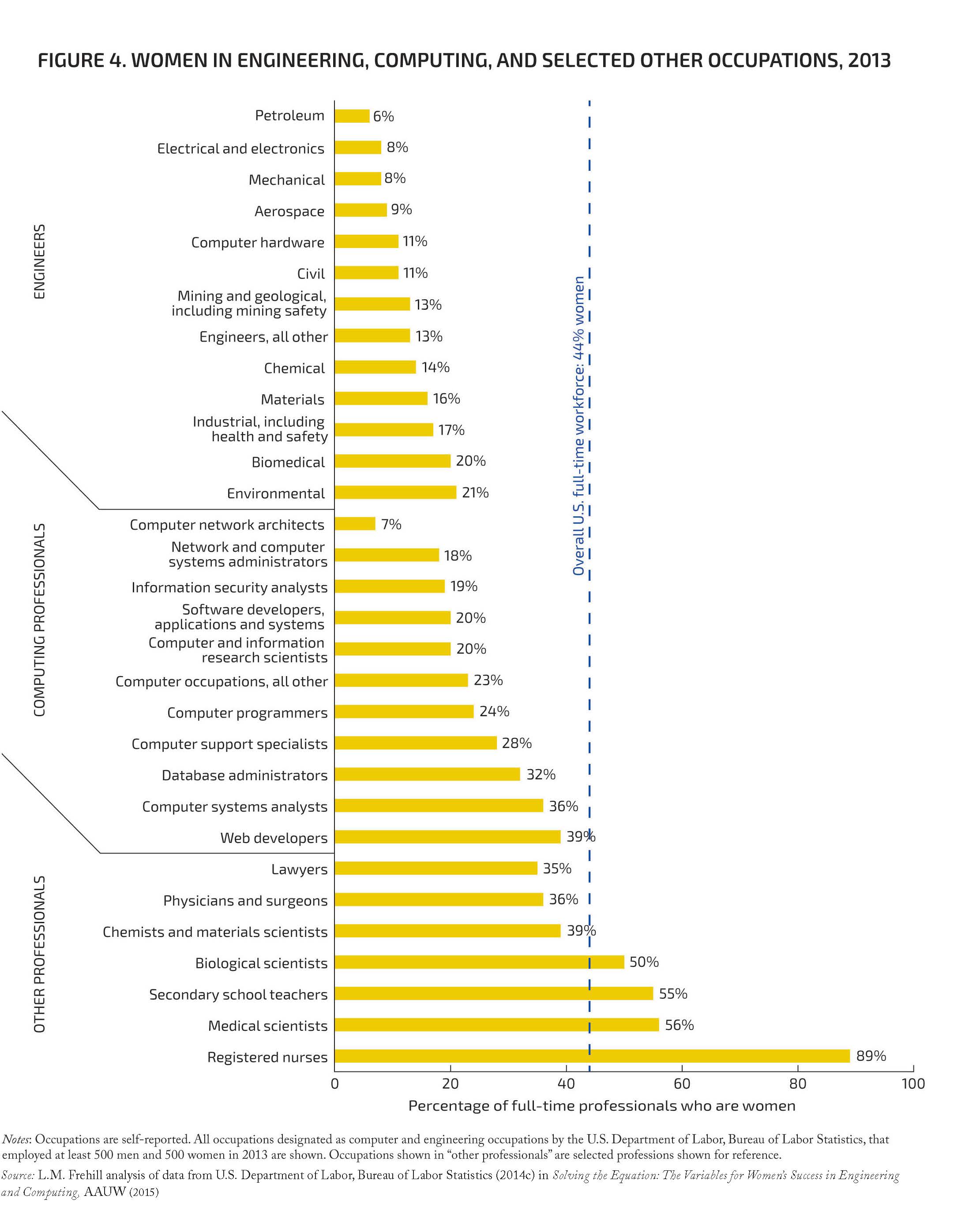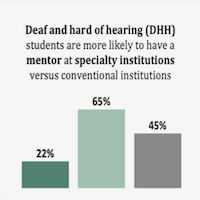Solving the Equation: The Variables for Women’s Success in Engineering and Computing
More than ever before in history, girls are studying and excelling in science and mathematics. Yet the dramatic increase in girls’ educational achievements in scientific and mathematical subjects has not been matched by similar increases in the representation of women working as engineers and computing professionals. Women made up just 26 percent of computing professionals in 2013, a substantially smaller portion than the 35 percent women comprised in 1990 and about the same percentage as in 1960. In engineering, women are even less well represented, making up just 12 percent of working engineers in 2013.
With funding from the National Science Foundation, the American Association of University Women (AAUW) recently released Solving the Equation: The Variables for Women’s Success in Engineering and Computing, which highlights recent research on the factors underlying the underrepresentation of women in these fields, including stereotypes and biases, college curriculum, and workplace environment, and makes evidence-based recommendations for change. Many of the recommendations are targeted toward employers as they play an especially important role in creating workplace environments that support women. Some specific recommendations include holding managers accountable for their hiring and promotion decisions so they’re less likely to rely on stereotypes; removing gender information from job applications and evaluation scenarios when possible; making clear that a workplace with more technical women is a priority and a desired goal for an organization; and emphasizing the societal benefit of engineering and computing work.
Combating Stereotypes and Biases
We all hold gender biases, shaped by cultural stereotypes in the wider culture, that affect how we evaluate and treat one another. Several recent research findings shed light on the effects of stereotypes and gender bias as they relate to women in engineering and computing.
Many of you are likely familiar with the recent study by Dr. Corinne Moss-Racusin and colleagues which found that scientists were more likely to choose a male candidate over an identical female candidate for a hypothetical job opening at a lab. Both female and male scientists also offered a higher salary to the male candidate. Another recent study by Dr. Ernesto Reuben and colleagues found that potential employers systematically underestimated the mathematical performance of women compared with men, resulting in the hiring of lower-performing men over higher-performing women for mathematical work. Once objective past-performance information was introduced, however, the employers made less biased hiring decisions. Bias is prevalent, but its effects can be diminished with more comprehensive information.
Hundreds of studies have documented the power of stereotypes to influence performance through a phenomenon known as “stereotype threat” in many domains, including academic performance among black students, memory in older adults, girls’ chess performance, and women’s athletic performance. In every case even subtle reminders of negative stereotypes can have an impact on performance, sometimes in dramatic ways. For example, according to a recent meta-analysis, stereotype threat results in an underestimation of the intellectual ability of black and Latino students by approximately 40 points on the SAT math and reading tests.
Stereotype threat occurs when individuals fear that they will confirm a negative stereotype about a group to which they belong. One such group is “women.” When negative stereotypes about women’s mathematical abilities are brought to test-takers’ attention during tests, women’s performance drops. Stereotype threat has been theorized not only to influence women’s mathematical performance but also to contribute to disengagement from fields in which women are negatively stereotyped, such as engineering and computing.
Much research has been done on how stereotype threat can affect academic performance, but researchers are only recently beginning to examine how stereotype threat affects women in the workplace. One finding in this area, from a study conducted by Dr. Shannon Holleran, Dr. Toni Schmader, and their colleagues, showed that the more often female STEM faculty had research-related conversations with their male colleagues, the less engaged they felt with their work. In contrast, the more social conversations female STEM faculty had with their male colleagues, the more engaged they reported being with their work. One possible explanation for this finding is that research-related conversations with male colleagues may generate stereotype threat for female scientists. Social conversations with male colleagues, on the other hand, may lessen the threat by increasing a feeling of belonging in their work environment. Research suggests that stereotypes are activated for women more frequently when few women work in an organization. The presence of women at all levels of an organization has the potential to create environments that are less threatening for women.
Gender biases affect not only how we view and treat others but also how we view ourselves and what actions we take as a result. As early as first grade, children have already developed implicit biases associating math with boys. Studies suggest that girls who more strongly associate math with boys and men are less likely to perceive themselves as being interested in or skilled at math and less likely to spend time studying or engaging with math concepts.
A recent study conducted by Dr. Frederick Smyth, Dr. Brian Nosek, and Dr. Anthony Greenwald, to be published in a <href=”#overview”>forthcoming issue of Frontiers in Psychology finds that most men who major in engineering and computing have relatively strong implicit biases associating men with science, whereas their female counterparts tend to have relatively weak science-male implicit biases. Engineering and computing workplaces have a wider gap in gender-science bias among female and male employees relative to other fields. Exactly how this gender difference affects the work environment in engineering and computing is an area ripe for future research.
Emphasizing Social Relevance
Another factor that may contribute to girls and women choosing to pursue fields other than engineering and computing is the small but well-documented gender difference in desire to work with and help other people. Although communal goals are widely valued by both women and men, research conducted by Dr. Amanda Diekman and colleagues finds that women are more likely than men to prioritize helping and working with other people over other career goals. Engineering and computing jobs clearly can provide opportunities for fulfilling communal goals, but jobs in these fields are not generally viewed that way. Rather, engineering and computing are often thought of as solitary occupations that offer few opportunities for social contribution. The perception and, in some cases, the reality that engineering and computing occupations lack opportunities to work with and help others may in part explain the underrepresentation of women in these fields. Incorporating communal aspects—both in messaging and in substance—into engineering and computing work will likely increase the appeal of these fields to communally oriented people, many of whom are women.
Cultivating a Sense of Belonging
Perhaps because of this combination of stereotypes, biases, and values, women often report that they don’t feel as if they belong in engineering and computing fields. A recent study by Dr. Erin Cech and colleagues found that female engineering students were less likely than their male counterparts to feel a strong sense of fit with the idea of “being an engineer” as early as their first year in college. This more tenuous sense of fit with the professional role of an engineer was found to be associated with a greater likelihood of leaving the field. By emphasizing the wide variety of expertise necessary to be a successful engineer or computing professional—including less stereotypically masculine skills such as writing, communicating, and organizing—college engineering and computing programs can help young women see engineering and computing as fields in which they belong.
Changing the Environment
Past decades have shown that simply trying to recruit girls and women into existing engineering and computing educational programs and workplaces has had limited success. Changing the environment in college and the workplace appears to be a prerequisite for fully integrating women into these fields.
College
Harvey Mudd College is a prime example of how changing structures and environments can result in a dramatic increase in women’s representation in computing. With leadership from the college president Marie Klawe, and college-wide support, Harvey Mudd increased the percentage of women graduating from its computing program from 12 percent to approximately 40 percent in five years. This dramatic increase was accomplished through three major changes: revising the introductory computing course and splitting it into two levels divided by experience, providing research opportunities for undergraduates after their first year in college, and taking female students to the Grace Hopper Celebration of Women in Computing conference. These changes can be modified and applied at other colleges and universities. Taken together, they provide a roadmap for reversing the downward trend in women’s representation among bachelor’s degree recipients in computing.
The Workplace
Finally, while many studies have focused on factors contributing to women entering STEM occupations, far fewer have looked at the arguably equally important question of why women leave these fields, often after years of preparation, and what factors support them in staying. Recent research by Dr. Nadya Fouad and colleagues sheds light on why some women leave the engineering workforce and why others stay. Women who leave engineering are very similar to women who stay in engineering. The differences the researchers found were not in the women themselves but in their workplace environments.
Women who left engineering were less likely to have opportunities for training and development, support from co-workers or supervisors, and support for balancing work and non-work roles than were women who stayed in the profession. Female engineers who were most satisfied with their jobs, in contrast, worked for organizations that provided clear paths for advancement, gave employees challenging assignments that helped develop and strengthen new skills, and valued and recognized employees’ contributions.
Stereotypes and biases lie at the core of the challenges facing women in engineering and computing. Educational and workplace environments are dissuading women who might otherwise succeed in these fields. Expanding women’s representation in engineering and computing will require concerted effort by employers, educational institutions, policy makers, and individuals to create environments that are truly welcoming for women.
Christianne Corbett is a senior researcher at the American Association of University Women. Patty Lopez served as an advisor for Solving the Equation.










